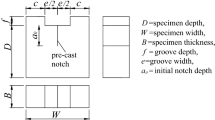Abstract
In this paper, we present a damage model and its numerical solution by means of Fast Fourier Transforms (FFT). The FFT-based formulation initially proposed for linear and non-linear composite homogenization (Moulinec and Suquet in CR Acad Sci Paris Ser II 318:1417–1423 1994; Comput Methods Appl Mech Eng 157:69–94 1998) was adapted to evaluate damage growth in brittle materials. A non-local damage model based on the maximal principal stress criterion was proposed for brittle materials. This non-local model was then connected to the Griffith criterion with the aim of predicting crack growth. By using the proposed model, we carried out several numerical simulations on different specimens in order to assess the fracture process in brittle materials. From these studies, we can conclude that the present FFT-based analysis is capable of dealing with crack initiation and crack growth in brittle materials with high accuracy and efficiency.
Similar content being viewed by others
References
Bilger N, Auslender F, Bornert M, Moulinec H, Zaoui A (2007) Bounds and estimates for the effective yield surface of porous media with a uniform or a nonuniform distribution of voids. Euro J Mech A/Solids 26: 810–836
Carpinteri A, Ciola F, Pugno N (2001) Boundary element method for the strain-softening response of quasi-brittle materials in compression. Comput Struct 79: 389–401
Carpinteri A, Yang GP (1997) Size effects in brittle specimen with micro crack interaction. Comput Struct 63: 429–437
Dienes GJ, Paskin A (1987) Molecular dynamic simulations of crack propagation. J Phys Chem Solids 48(11): 1015–1033
Frost NE (1959) A relation between the critical alternating propagation stress and crack length for mild steel. Proc Inst Mech Eng 173: 811–827
Griffith AA (1920) The phenomena of rupture and flow in solids. Philos Trans R Soc Lond 221: 163–198
Idiarta MI, Moulinec H, Ponte Castaneda P, Suquet P (2006) Macroscopic behavior and field fluctuations in viscoplastic composites: Second-order estimates versus full-field simulations. J Mech Phys Solids 54: 1029–1063
Irwin G (1968) Linear fracture mechanics, fracture transition and fracture control. Eng Fract Mech 1: 241–257
Karihaloo BL, Shao PF, Xiao QZ (2003) Lattice modelling of the failure of particle composites. Eng Fract Mech 70-2385–2406
Kitagawa H, Takahashi S (1976) Applicability of fracture mechanics to very small cracks or the cracks in the early stage. In: Proceedings of 2nd International Conference on mechanical behaviour of materials, Boston, pp 627–631
Lankford J (1986) The influence of microstructure on the growth of small fatigue crack. Fatigue Fract Eng Mater Struct 8: 161–175
Lebensohn RA, Bringa EM, Caro A (2007) A viscoplastic micromechanical model for the yield strength of nanocrystalline materials. Acta Mater 55: 261–271
Lebensohn RA, Liu Y, Ponte Castañeda P (2004) On the accuracy of the self-consistent approximation for polycrystals: comparison with full-field numerical simulations. Acta Mater 52: 5347–5361
Lilliu G, van Mier JGM (2003) 3D lattice type fracture model for concrete. Eng Fract Mech 70: 927–941
Liu WK, Karpov EG, Zhang S, Park HS (2004) An introduction to computational nano mechanics and materials. Comput Methods Appl Mech Eng 193: 1529–1578
Michel JC, Moulinec H, Suquet P (2000) Computational method based on augmented lagrangians and fast Fourier transforms for composites with high contrast. Comput Model Eng Sci 1(2): 79–88
Michel JC, Moulinec H, Suquet P (1999) Effective properties of composites materials with periodic microstructure: a computational approach. Comput Methods Appl Mech Eng 172: 109–143
Moulinec H, Suquet P (1994) A fast numerical method for computing the linear and the nonlinear mechanical properties of composites. CR Acad Sci Paris Ser II 318: 1417–1423
Moulinec H, Suquet P (1998) A numerical method for computing the overall response of nonlinear composites with complex microstructure. Comput Methods Appl Mech Eng 157: 69–94
Mullins M (1982) Molecular dynamics simulation of propagating cracks Original Research Article. Scr Metallurgica 16-6: 663–666
Nguyen TK, Sab K, Bonnet G (2008) Green’s operator for a periodic medium with traction-free boundary conditions and computation of the effective properties of thin plates. Int J Solids Struct 45: 6518–6534
Ostoja-Starzewski M, Sheng PY, Alzebdeh K (1996) Spring network models in elasticity and fracture of composites and polycrystals. Comput Mater Sci 7: 82–93
Pijaudier-Cabot G, Bazant ZP (1987) Nonlocal damage theory. J Eng Mech ASCE 113: 1512–1533
Sih G (1973) Handbook of stress-intensity factors. Lehigh University, Bethlehem
Williams ML (1961) The bending stress distribution at the base of a stationary crack. J Appl Mech 28: 78–82
Zhang XB, Li J, Boukha SE (2009) Modelling the failure behaviour of brittle or quasi-brittle materials by analyzing the growth of micro-cracks. Int J Fract 160: 73–83
Zimbelmann R (1985) A contribution to the problem of cement-aggregate bond. Cem Conc Res 15: 801–808
Author information
Authors and Affiliations
Corresponding author
Rights and permissions
About this article
Cite this article
Li, J., Tian, XX. & Abdelmoula, R. A damage model for crack prediction in brittle and quasi-brittle materials solved by the FFT method. Int J Fract 173, 135–146 (2012). https://doi.org/10.1007/s10704-011-9671-1
Received:
Accepted:
Published:
Issue Date:
DOI: https://doi.org/10.1007/s10704-011-9671-1




